Business Decision Making Report: ABC Plc Investment Analysis
VerifiedAdded on 2023/01/13
|8
|1275
|44
Report
AI Summary
This report examines business decision-making processes, specifically focusing on investment choices for ABC plc. It utilizes capital budgeting tools like Net Present Value (NPV) and payback period to evaluate the viability of potential projects, comparing a motor software project (A) and a hardware project (B). The analysis includes calculating and interpreting the NPV and payback periods for each project, concluding that the hardware project (B) is the more profitable investment, with an NPV of £24,430 and a payback period of 3.2 years. Furthermore, the report emphasizes the importance of considering both financial and non-financial factors, such as resource availability, risk assessment, and external environmental aspects, to make informed strategic decisions. It concludes that the application of investment appraisal tools is crucial for selecting the most beneficial projects, thus supporting organizational goals.

Business Decision Making
Paraphrase This Document
Need a fresh take? Get an instant paraphrase of this document with our AI Paraphraser
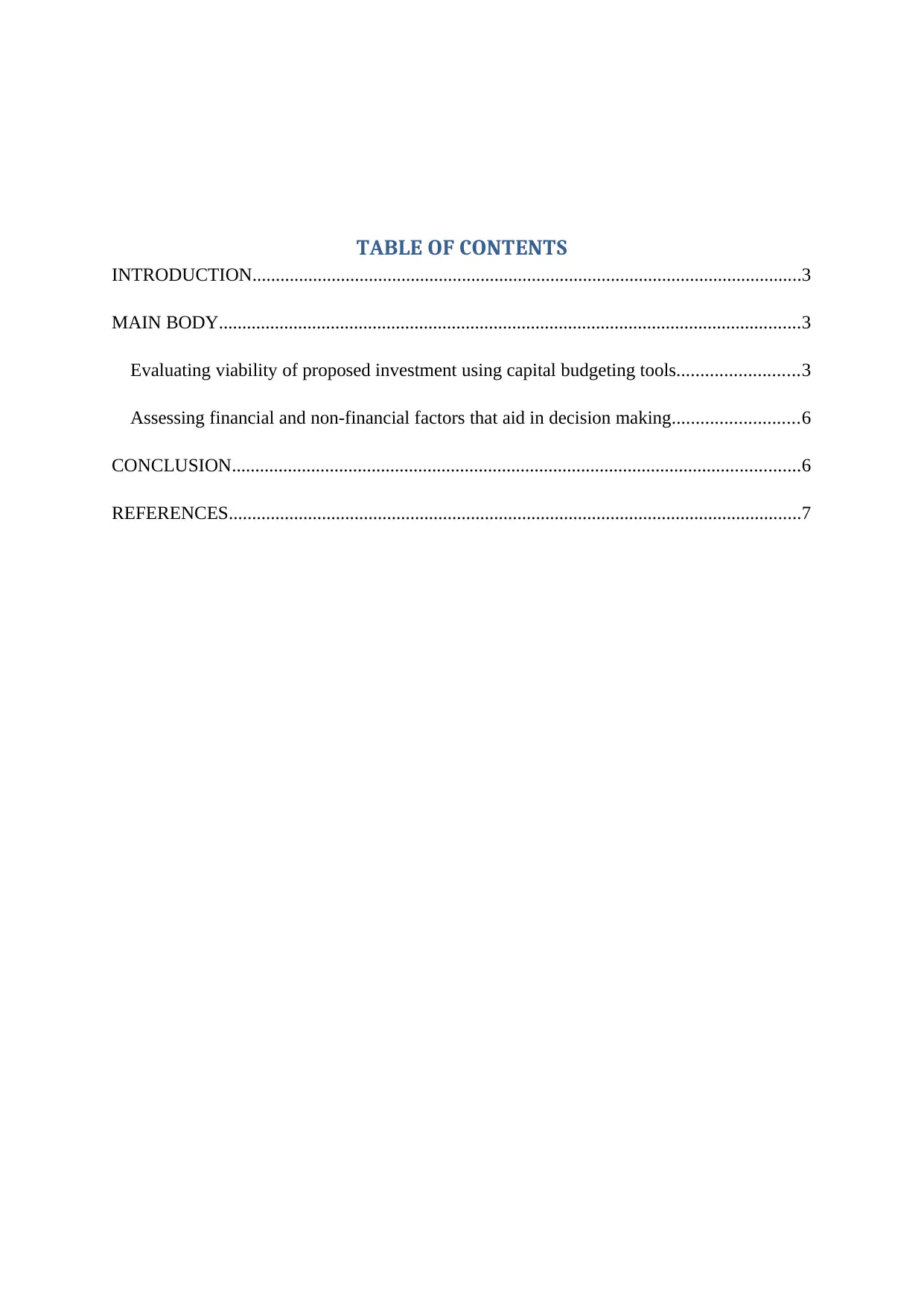
TABLE OF CONTENTS
INTRODUCTION......................................................................................................................3
MAIN BODY.............................................................................................................................3
Evaluating viability of proposed investment using capital budgeting tools..........................3
Assessing financial and non-financial factors that aid in decision making...........................6
CONCLUSION..........................................................................................................................6
REFERENCES...........................................................................................................................7
INTRODUCTION......................................................................................................................3
MAIN BODY.............................................................................................................................3
Evaluating viability of proposed investment using capital budgeting tools..........................3
Assessing financial and non-financial factors that aid in decision making...........................6
CONCLUSION..........................................................................................................................6
REFERENCES...........................................................................................................................7
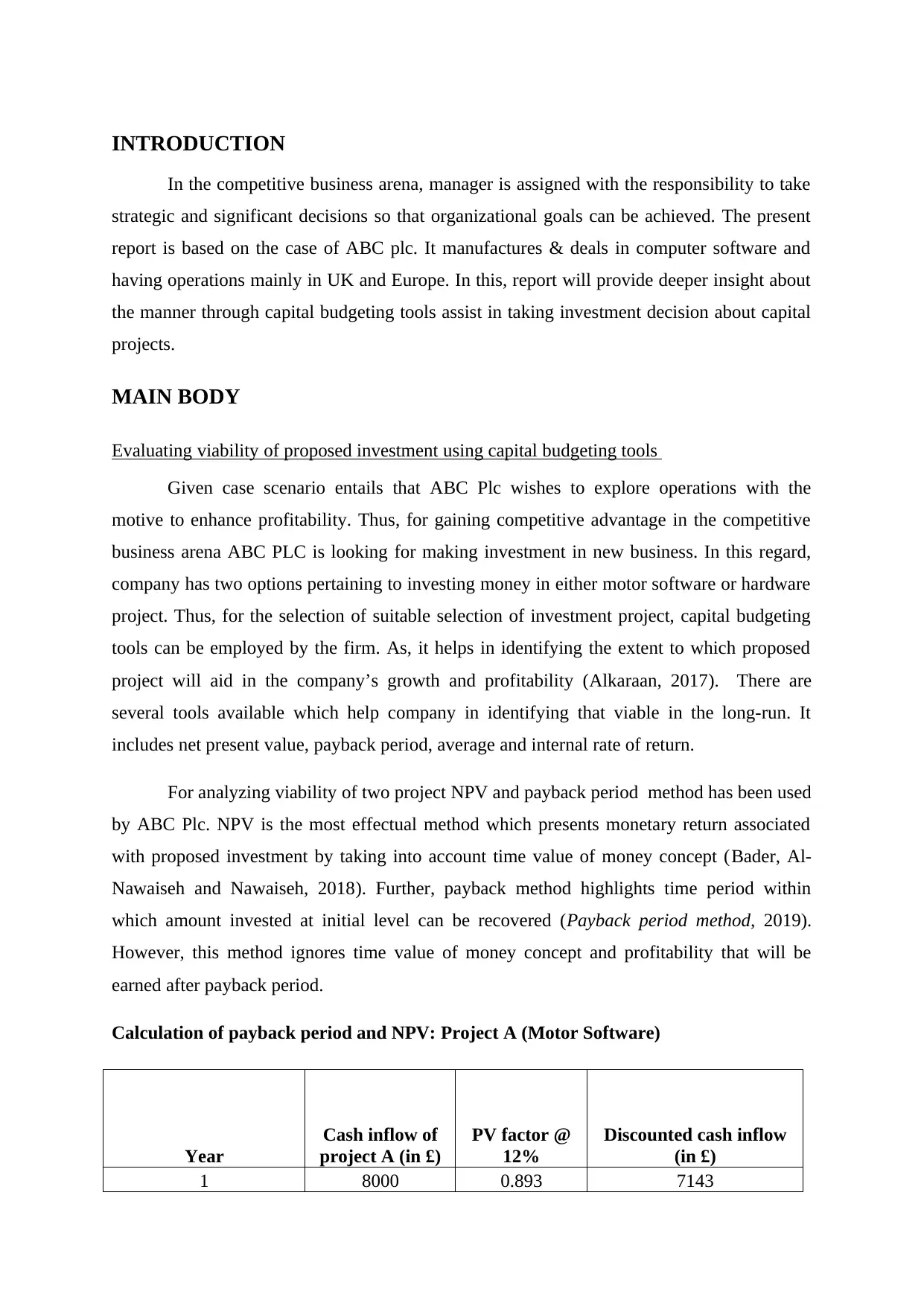
INTRODUCTION
In the competitive business arena, manager is assigned with the responsibility to take
strategic and significant decisions so that organizational goals can be achieved. The present
report is based on the case of ABC plc. It manufactures & deals in computer software and
having operations mainly in UK and Europe. In this, report will provide deeper insight about
the manner through capital budgeting tools assist in taking investment decision about capital
projects.
MAIN BODY
Evaluating viability of proposed investment using capital budgeting tools
Given case scenario entails that ABC Plc wishes to explore operations with the
motive to enhance profitability. Thus, for gaining competitive advantage in the competitive
business arena ABC PLC is looking for making investment in new business. In this regard,
company has two options pertaining to investing money in either motor software or hardware
project. Thus, for the selection of suitable selection of investment project, capital budgeting
tools can be employed by the firm. As, it helps in identifying the extent to which proposed
project will aid in the company’s growth and profitability (Alkaraan, 2017). There are
several tools available which help company in identifying that viable in the long-run. It
includes net present value, payback period, average and internal rate of return.
For analyzing viability of two project NPV and payback period method has been used
by ABC Plc. NPV is the most effectual method which presents monetary return associated
with proposed investment by taking into account time value of money concept (Bader, Al-
Nawaiseh and Nawaiseh, 2018). Further, payback method highlights time period within
which amount invested at initial level can be recovered (Payback period method, 2019).
However, this method ignores time value of money concept and profitability that will be
earned after payback period.
Calculation of payback period and NPV: Project A (Motor Software)
Year
Cash inflow of
project A (in £)
PV factor @
12%
Discounted cash inflow
(in £)
1 8000 0.893 7143
In the competitive business arena, manager is assigned with the responsibility to take
strategic and significant decisions so that organizational goals can be achieved. The present
report is based on the case of ABC plc. It manufactures & deals in computer software and
having operations mainly in UK and Europe. In this, report will provide deeper insight about
the manner through capital budgeting tools assist in taking investment decision about capital
projects.
MAIN BODY
Evaluating viability of proposed investment using capital budgeting tools
Given case scenario entails that ABC Plc wishes to explore operations with the
motive to enhance profitability. Thus, for gaining competitive advantage in the competitive
business arena ABC PLC is looking for making investment in new business. In this regard,
company has two options pertaining to investing money in either motor software or hardware
project. Thus, for the selection of suitable selection of investment project, capital budgeting
tools can be employed by the firm. As, it helps in identifying the extent to which proposed
project will aid in the company’s growth and profitability (Alkaraan, 2017). There are
several tools available which help company in identifying that viable in the long-run. It
includes net present value, payback period, average and internal rate of return.
For analyzing viability of two project NPV and payback period method has been used
by ABC Plc. NPV is the most effectual method which presents monetary return associated
with proposed investment by taking into account time value of money concept (Bader, Al-
Nawaiseh and Nawaiseh, 2018). Further, payback method highlights time period within
which amount invested at initial level can be recovered (Payback period method, 2019).
However, this method ignores time value of money concept and profitability that will be
earned after payback period.
Calculation of payback period and NPV: Project A (Motor Software)
Year
Cash inflow of
project A (in £)
PV factor @
12%
Discounted cash inflow
(in £)
1 8000 0.893 7143
⊘ This is a preview!⊘
Do you want full access?
Subscribe today to unlock all pages.

Trusted by 1+ million students worldwide
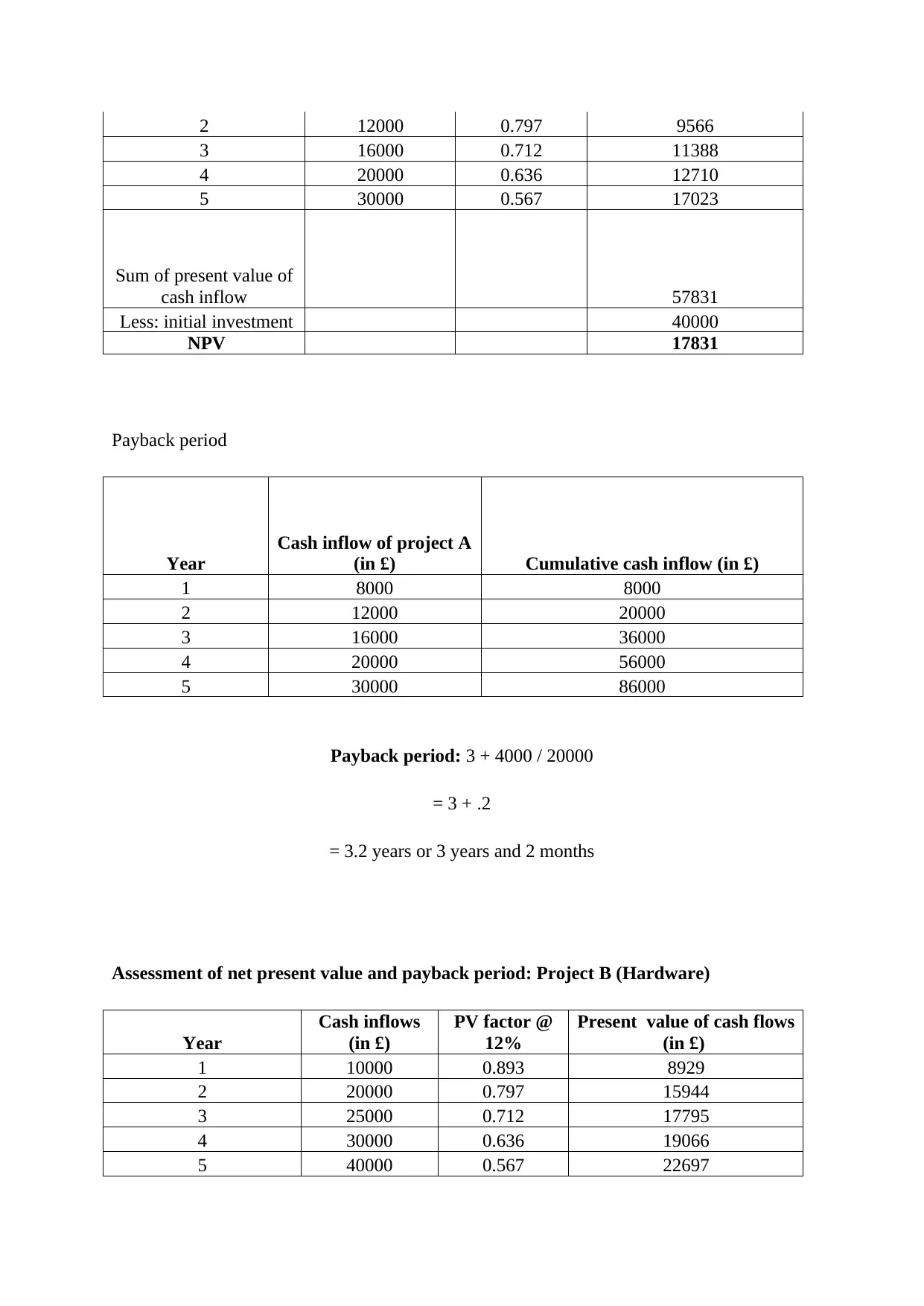
2 12000 0.797 9566
3 16000 0.712 11388
4 20000 0.636 12710
5 30000 0.567 17023
Sum of present value of
cash inflow 57831
Less: initial investment 40000
NPV 17831
Payback period
Year
Cash inflow of project A
(in £) Cumulative cash inflow (in £)
1 8000 8000
2 12000 20000
3 16000 36000
4 20000 56000
5 30000 86000
Payback period: 3 + 4000 / 20000
= 3 + .2
= 3.2 years or 3 years and 2 months
Assessment of net present value and payback period: Project B (Hardware)
Year
Cash inflows
(in £)
PV factor @
12%
Present value of cash flows
(in £)
1 10000 0.893 8929
2 20000 0.797 15944
3 25000 0.712 17795
4 30000 0.636 19066
5 40000 0.567 22697
3 16000 0.712 11388
4 20000 0.636 12710
5 30000 0.567 17023
Sum of present value of
cash inflow 57831
Less: initial investment 40000
NPV 17831
Payback period
Year
Cash inflow of project A
(in £) Cumulative cash inflow (in £)
1 8000 8000
2 12000 20000
3 16000 36000
4 20000 56000
5 30000 86000
Payback period: 3 + 4000 / 20000
= 3 + .2
= 3.2 years or 3 years and 2 months
Assessment of net present value and payback period: Project B (Hardware)
Year
Cash inflows
(in £)
PV factor @
12%
Present value of cash flows
(in £)
1 10000 0.893 8929
2 20000 0.797 15944
3 25000 0.712 17795
4 30000 0.636 19066
5 40000 0.567 22697
Paraphrase This Document
Need a fresh take? Get an instant paraphrase of this document with our AI Paraphraser
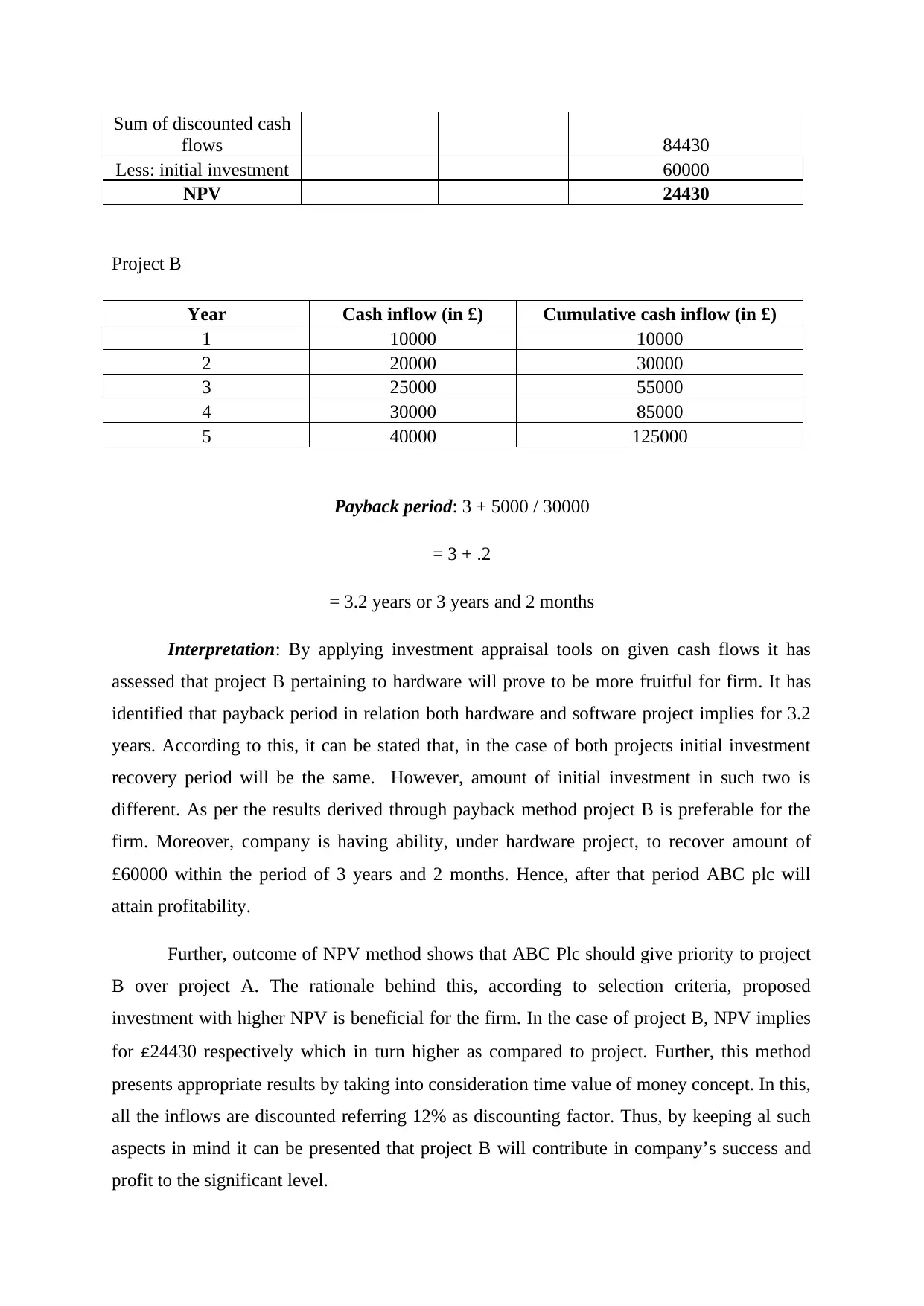
Sum of discounted cash
flows 84430
Less: initial investment 60000
NPV 24430
Project B
Year Cash inflow (in £) Cumulative cash inflow (in £)
1 10000 10000
2 20000 30000
3 25000 55000
4 30000 85000
5 40000 125000
Payback period: 3 + 5000 / 30000
= 3 + .2
= 3.2 years or 3 years and 2 months
Interpretation: By applying investment appraisal tools on given cash flows it has
assessed that project B pertaining to hardware will prove to be more fruitful for firm. It has
identified that payback period in relation both hardware and software project implies for 3.2
years. According to this, it can be stated that, in the case of both projects initial investment
recovery period will be the same. However, amount of initial investment in such two is
different. As per the results derived through payback method project B is preferable for the
firm. Moreover, company is having ability, under hardware project, to recover amount of
£60000 within the period of 3 years and 2 months. Hence, after that period ABC plc will
attain profitability.
Further, outcome of NPV method shows that ABC Plc should give priority to project
B over project A. The rationale behind this, according to selection criteria, proposed
investment with higher NPV is beneficial for the firm. In the case of project B, NPV implies
for £24430 respectively which in turn higher as compared to project. Further, this method
presents appropriate results by taking into consideration time value of money concept. In this,
all the inflows are discounted referring 12% as discounting factor. Thus, by keeping al such
aspects in mind it can be presented that project B will contribute in company’s success and
profit to the significant level.
flows 84430
Less: initial investment 60000
NPV 24430
Project B
Year Cash inflow (in £) Cumulative cash inflow (in £)
1 10000 10000
2 20000 30000
3 25000 55000
4 30000 85000
5 40000 125000
Payback period: 3 + 5000 / 30000
= 3 + .2
= 3.2 years or 3 years and 2 months
Interpretation: By applying investment appraisal tools on given cash flows it has
assessed that project B pertaining to hardware will prove to be more fruitful for firm. It has
identified that payback period in relation both hardware and software project implies for 3.2
years. According to this, it can be stated that, in the case of both projects initial investment
recovery period will be the same. However, amount of initial investment in such two is
different. As per the results derived through payback method project B is preferable for the
firm. Moreover, company is having ability, under hardware project, to recover amount of
£60000 within the period of 3 years and 2 months. Hence, after that period ABC plc will
attain profitability.
Further, outcome of NPV method shows that ABC Plc should give priority to project
B over project A. The rationale behind this, according to selection criteria, proposed
investment with higher NPV is beneficial for the firm. In the case of project B, NPV implies
for £24430 respectively which in turn higher as compared to project. Further, this method
presents appropriate results by taking into consideration time value of money concept. In this,
all the inflows are discounted referring 12% as discounting factor. Thus, by keeping al such
aspects in mind it can be presented that project B will contribute in company’s success and
profit to the significant level.
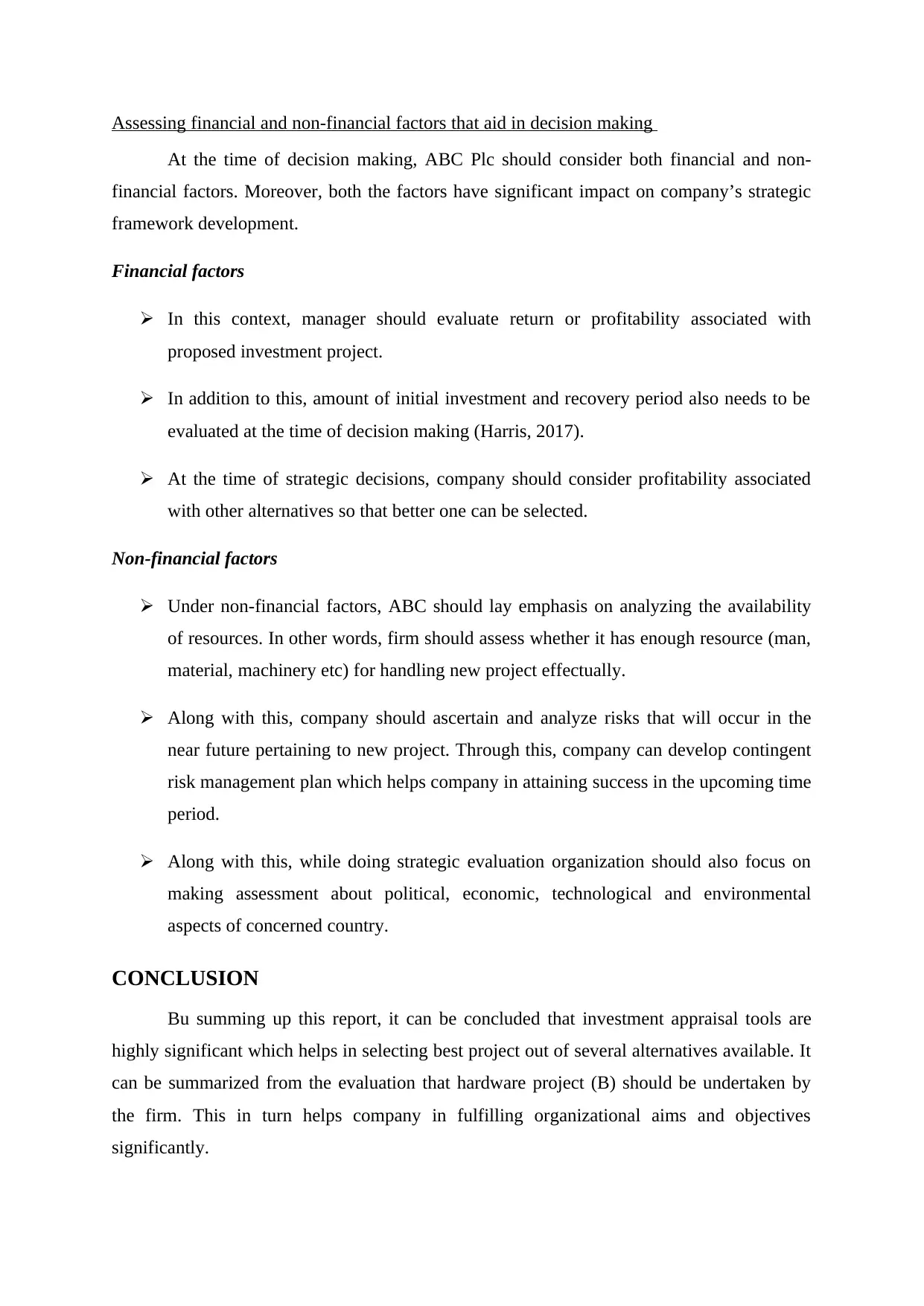
Assessing financial and non-financial factors that aid in decision making
At the time of decision making, ABC Plc should consider both financial and non-
financial factors. Moreover, both the factors have significant impact on company’s strategic
framework development.
Financial factors
In this context, manager should evaluate return or profitability associated with
proposed investment project.
In addition to this, amount of initial investment and recovery period also needs to be
evaluated at the time of decision making (Harris, 2017).
At the time of strategic decisions, company should consider profitability associated
with other alternatives so that better one can be selected.
Non-financial factors
Under non-financial factors, ABC should lay emphasis on analyzing the availability
of resources. In other words, firm should assess whether it has enough resource (man,
material, machinery etc) for handling new project effectually.
Along with this, company should ascertain and analyze risks that will occur in the
near future pertaining to new project. Through this, company can develop contingent
risk management plan which helps company in attaining success in the upcoming time
period.
Along with this, while doing strategic evaluation organization should also focus on
making assessment about political, economic, technological and environmental
aspects of concerned country.
CONCLUSION
Bu summing up this report, it can be concluded that investment appraisal tools are
highly significant which helps in selecting best project out of several alternatives available. It
can be summarized from the evaluation that hardware project (B) should be undertaken by
the firm. This in turn helps company in fulfilling organizational aims and objectives
significantly.
At the time of decision making, ABC Plc should consider both financial and non-
financial factors. Moreover, both the factors have significant impact on company’s strategic
framework development.
Financial factors
In this context, manager should evaluate return or profitability associated with
proposed investment project.
In addition to this, amount of initial investment and recovery period also needs to be
evaluated at the time of decision making (Harris, 2017).
At the time of strategic decisions, company should consider profitability associated
with other alternatives so that better one can be selected.
Non-financial factors
Under non-financial factors, ABC should lay emphasis on analyzing the availability
of resources. In other words, firm should assess whether it has enough resource (man,
material, machinery etc) for handling new project effectually.
Along with this, company should ascertain and analyze risks that will occur in the
near future pertaining to new project. Through this, company can develop contingent
risk management plan which helps company in attaining success in the upcoming time
period.
Along with this, while doing strategic evaluation organization should also focus on
making assessment about political, economic, technological and environmental
aspects of concerned country.
CONCLUSION
Bu summing up this report, it can be concluded that investment appraisal tools are
highly significant which helps in selecting best project out of several alternatives available. It
can be summarized from the evaluation that hardware project (B) should be undertaken by
the firm. This in turn helps company in fulfilling organizational aims and objectives
significantly.
⊘ This is a preview!⊘
Do you want full access?
Subscribe today to unlock all pages.

Trusted by 1+ million students worldwide

Paraphrase This Document
Need a fresh take? Get an instant paraphrase of this document with our AI Paraphraser
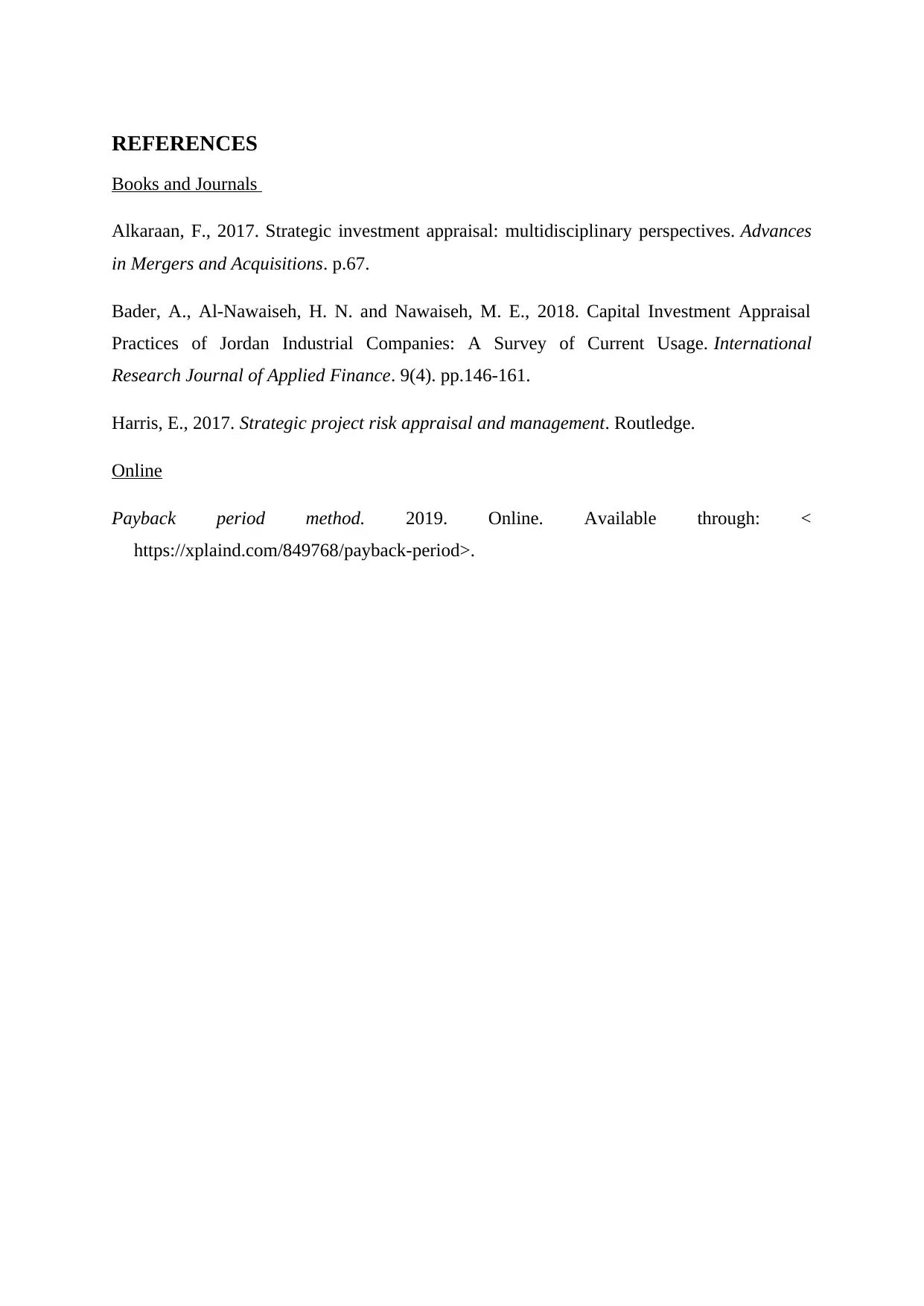
REFERENCES
Books and Journals
Alkaraan, F., 2017. Strategic investment appraisal: multidisciplinary perspectives. Advances
in Mergers and Acquisitions. p.67.
Bader, A., Al-Nawaiseh, H. N. and Nawaiseh, M. E., 2018. Capital Investment Appraisal
Practices of Jordan Industrial Companies: A Survey of Current Usage. International
Research Journal of Applied Finance. 9(4). pp.146-161.
Harris, E., 2017. Strategic project risk appraisal and management. Routledge.
Online
Payback period method. 2019. Online. Available through: <
https://xplaind.com/849768/payback-period>.
Books and Journals
Alkaraan, F., 2017. Strategic investment appraisal: multidisciplinary perspectives. Advances
in Mergers and Acquisitions. p.67.
Bader, A., Al-Nawaiseh, H. N. and Nawaiseh, M. E., 2018. Capital Investment Appraisal
Practices of Jordan Industrial Companies: A Survey of Current Usage. International
Research Journal of Applied Finance. 9(4). pp.146-161.
Harris, E., 2017. Strategic project risk appraisal and management. Routledge.
Online
Payback period method. 2019. Online. Available through: <
https://xplaind.com/849768/payback-period>.
1 out of 8
Related Documents
Your All-in-One AI-Powered Toolkit for Academic Success.
+13062052269
info@desklib.com
Available 24*7 on WhatsApp / Email
![[object Object]](/_next/static/media/star-bottom.7253800d.svg)
Unlock your academic potential
Copyright © 2020–2025 A2Z Services. All Rights Reserved. Developed and managed by ZUCOL.





